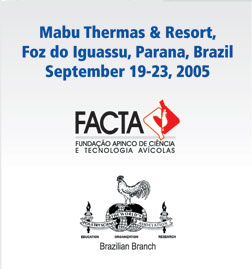Maternal Protection against
Eimeria challenge of CoxAbic® vaccinated chickens
Avner
Finger & Amnon Michael,
ABIC Biological Laboratories TEVA, ISRAEL
Abstract
CoxAbic®, the subunit vaccine was tested for its
ability to protect young broiler chicks by way of
Maternal Immunity. Broiler breeder pullets were twice
vaccinated with the vaccine during rearing. Eggs collected
from these and from unvaccinated hens were hatched
and groups of the offspring chicks were raised on
litter floor cages. On day 8 after hatch, a simulated
natural exposure was applied by infecting orally 1
chick from every 13 chicks with 50 sporulated oocysts
each of four species of coccidia – E. maxima,
acervulina, tenella and mitis. Groups of chicks were
kept on wire floored cages unexposed to coccidia and
served as negative controls. On day 35 groups of the
chicks were orally challenged with one of the four
Eimeria species (80,000 oocysts of E. acervulina,
25,000 maxima, 120,000 mitis and 25,000 tenella).
Oocysts were counted in the litter (OPG) after the
exposure of the seeder chicks and after challenge.
Body weights were recorded before and after challenge.
OPG indicated that the simulated natural exposure
to coccidia resulted in infection of the birds through
cycling parasites. Chicks from vaccinated and unvaccinated
dams became actively immune by way of the exposure
as elicited by their resistance to the challenge at
35 days of age in comparison to the negative control
chickens. The difference between the two groups was
expressed in their body weights. There was a consistent
gap of approximately 25% in favor of the CoxAbic ®
chicks, which was recorded after the early exposure
through rearing until the end of the trial at 55 days
of age.
The trial showed that maternal immunity protects broiler
chicks from the effects of early exposure to coccidian
parasites. This early natural exposure to the ubiquitous
parasite is the way that chicks become actively immune
to coccidiosis, but in birds without the protection
of maternal antibodies (or of coccidiostats in their
feed), this early exposure results in a significant
and economically important weight reduction, from
which CoxAbic® chicks are spared.
